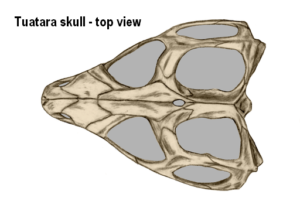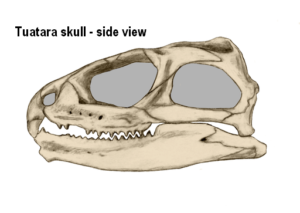The tuatara skull only deepens its mystery.


The tuatara is a reptile, but not a lizard; it is so far in its own clade of the class of reptiles. The small hole in the center of the skull appears to be where the tuatara’s third eye, mentioned earlier in this article and in the first video, may occur. The third eye is said to have the characteristics of an eye, but is only visible in a newborn tuatara and is soon covered by skin and scales.
Diapsids (“two arches”) are a group of amniote tetrapods that developed two holes (temporal fenestra) in each side of their skulls about 300 million years ago during the late Carboniferous period.[1] The diapsids are extremely diverse, and include all crocodiles, lizards, snakes, tuatara, birds and non-avian dinosaurs. Although some diapsids have lost either one hole (lizards), or both holes (snakes), or have a heavily restructured skull (modern birds), they are still classified as diapsids based on their ancestry. At least 7,925 species of diapsid reptiles[2] exist in environments around the world today (nearly 18,000 when birds are included).
Source of the above description: Wikipedia
Drawings of Tuatara skull: By Nobu Tamura (http://spinops.blogspot.com) (Own work) via Wikimedia Commons



